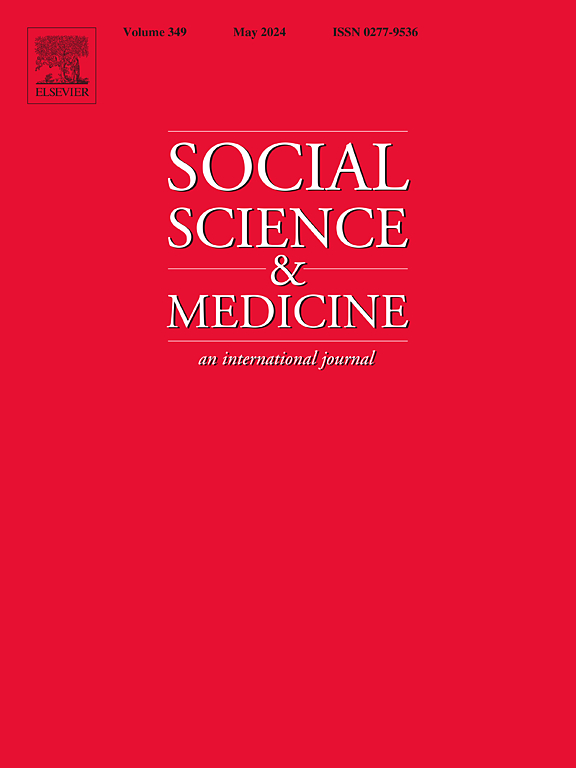自杀死亡率上升和下降背景下的自杀不平等变化:1995-2020 年韩国的情况
IF 4.9
2区 医学
Q1 PUBLIC, ENVIRONMENTAL & OCCUPATIONAL HEALTH
引用次数: 0
摘要
韩国的自杀死亡率在 2010 年前急剧上升,随后逐渐下降。本研究考察了 25 年来自杀中社会经济不平等现象的变化,以及自杀死亡率上升和下降背景下自杀不平等现象的变化。研究人员从 1995 年至 2020 年期间的韩国死亡登记和人口普查数据中提取了五年间隔的数据。利用泊松回归法,计算出了不平等指数斜率(SII)、相对不平等指数、比率比和比率差四种衡量自杀不平等的指标。在所有子人群、衡量指标和时期中,自杀的教育不平等现象都很明显。自杀不平等的扩大,尤其是绝对值的扩大,是随着 2010 年之前自杀死亡率的上升而出现的。与此相反,2010 年之后,在自杀死亡率下降期间,自杀不平等现象也随之减少。总人口中的自杀不平等指数下降了 35.4%,从 2010 年的每 10 万人 62.4 例(95% 置信区间 [CI],59.8-64.9)下降到 2020 年的 40.3 例(95% 置信区间,38.3-42.4)。在整个人口中观察到的自杀不平等扩大和缩小的模式仅与老年人口一致。然而,年轻和中年人口的不平等现象在整个期间呈现出逐渐增加或停滞的趋势。总体而言,自杀不平等现象在最近十年有所缩小。这一下降主要是由老年人口导致的,并归因于社会保护的提供。当提供的社会保护有利于受教育程度较低的人时,自杀不平等现象的减少会伴随着自杀死亡率的下降。本文章由计算机程序翻译,如有差异,请以英文原文为准。
Changes in suicide inequalities in the context of an increase and a decrease in suicide mortality: The case of South Korea, 1995–2020
South Korea experienced a sharp increase until 2010 followed by a gradual decrease in suicide mortality. This study examined changes in socioeconomic inequalities in suicide over 25 years and how suicide inequalities changed in the context of both an increase and a decrease in suicide mortality. Data with five-year intervals were extracted from the Korean death registry and census data between 1995 and 2020. Using Poisson regression, four measures of suicide inequalities were calculated for the slope of inequality index (SII), relative index of inequality, rate ratios, and ratio differences. Educational inequalities in suicide were obvious across all sub-populations, measures, and periods. The widening of suicide inequalities, particularly with absolute measures, followed an increase in suicide mortality until 2010. In contrast, a decline of suicide inequalities concurred after 2010 during the period of a decline in suicide mortality. SII among the total population decreased by 35.4%, from 62.4 per 100,000 people (95% confidence interval [CI], 59.8–64.9) in 2010 to 40.3 (95% CI, 38.3–42.4) in 2020. The pattern of widening and narrowing in suicide inequalities observed in the whole population was only concordant with the older population. However, the younger and the middle-aged population showed a gradual increase or stalemate in the inequalities throughout the period. Overall, suicide inequalities narrowed in the recent decade. This decline was largely led by the older population, and was attributed to the provision of social protection. A decline of suicide inequalities can accompany a decline in suicide mortality, when the provision of social protection favored the less educated.
求助全文
通过发布文献求助,成功后即可免费获取论文全文。
去求助
来源期刊

Social Science & Medicine
PUBLIC, ENVIRONMENTAL & OCCUPATIONAL HEALTH-
CiteScore
9.10
自引率
5.60%
发文量
762
审稿时长
38 days
期刊介绍:
Social Science & Medicine provides an international and interdisciplinary forum for the dissemination of social science research on health. We publish original research articles (both empirical and theoretical), reviews, position papers and commentaries on health issues, to inform current research, policy and practice in all areas of common interest to social scientists, health practitioners, and policy makers. The journal publishes material relevant to any aspect of health from a wide range of social science disciplines (anthropology, economics, epidemiology, geography, policy, psychology, and sociology), and material relevant to the social sciences from any of the professions concerned with physical and mental health, health care, clinical practice, and health policy and organization. We encourage material which is of general interest to an international readership.
 求助内容:
求助内容: 应助结果提醒方式:
应助结果提醒方式:


